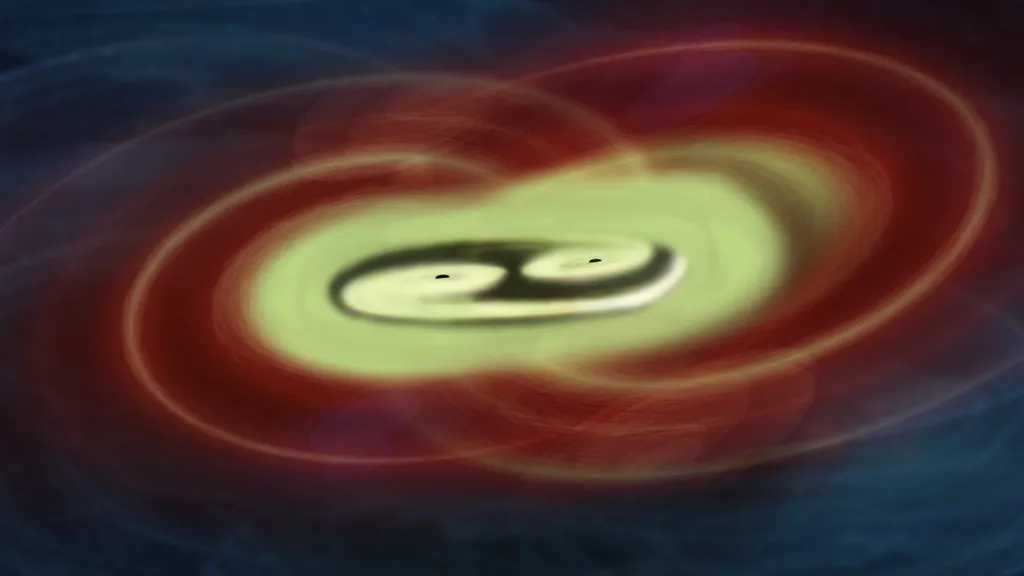The black hole twisted 10 billion times faster than any ever observed.
Researchers studying the aftermath of a gargantuan black hole collision may have confirmed a gravitational phenomenon predicted by Albert Einstein a century ago.
According to new research published today (Oct. 12) in the journal Nature(opens in new tab), the phenomenon — which is known as precession and is similar to the wobbling motion sometimes seen in a spinning top — occurred when two ancient black holes crashed together and merged into one. As the two massive objects swirled closer together, they released enormous ripples through the fabric of space-time known as gravitational waves, which surged outward across the cosmos, carrying energy and angular momentum away from the merging black holes.
Scientists first detected these waves emanating from the black holes in 2020, using the Laser Interferometer Gravitational-Wave Observatory (LIGO) in the U.S. and Virgo gravitational wave sensors in Italy. Now, after years of studying the wave patterns, researchers have confirmed that one of the black holes was rotating madly, to a degree never seen before.
The spinning black hole was twisting and turning 10 billion times faster than any previously observed black hole, which distorted space and time so much that it caused both black holes to wobble — or precess — in their orbits.
Researchers have observed precession in everything from spindle tops to dying star systems, but never in objects as enormous as binary black hole systems, in which the two cosmic vacuum cleaners orbit around a common center. However, Einstein's theory of general relativity predicted more than 100 years ago that precession should occur in objects as large as binary black holes. Now, the study authors say, this rare phenomenon has been observed in nature for the first time.
"We've always thought that binary black holes can do this," lead study author Mark Hannam, director of the Gravity Exploration Institute at Cardiff University in the U.K., said in a statement. "We have been hoping to spot an example ever since the first gravitational wave detections. We had to wait for five years and over 80 separate detections, but finally we have one!"
The black holes in question were many times more massive than the sun, with the larger of the two estimated at about 40 solar masses. Researchers first caught wind of the binary pair in 2020, when LIGO and Virgo detected a blast of gravitational waves released by the supposed collision of the two black holes. The team dubbed this collision GW200129, for the date of its discovery (Jan. 29, 2020).
Since then, other scientists have pored over that initial gravitational wave data, uncovering ever odder secrets about this epic collision. (Though because scientists only have gravitational waves to go on and no direct observations, they can't pinpoint the black holes' precise location).
For instance, in May 2022, a team of researchers calculated that the merger between the two black holes was both massive and lopsided, according to Live Science’s sister site Space.com, with gravitational waves blasting out of the collision in one direction while the newly merged black hole was likely "kicked" out of its home galaxy at more than 3 million mph (4.8 million km/h) in the opposite direction.
This new research in Nature suggests that the two black holes had a chaotic relationship before their violent merger. As the two gargantuan objects tugged at each other in an ever-closer orbit, they began to wobble like tipsy tops, precessing several times every second. According to the study authors, this precessing effect is estimated to be 10 billion times faster than any other ever measured.
These findings vindicate Einstein, who predicted that such effects were possible in some of the universe's largets objects. But the results also raise the question as to whether wibbly wobbly black hole mergers like this one are as rare as once thought.
"The larger black hole in this binary, which was about 40 times more massive than the Sun, was spinning almost as fast as physically possible," said study co-author Charlie Hoy, a researcher at Cardiff University at the time of the study, and now at the University of Portsmouth in the U.K. "Our current models of how binaries form suggest this one was extremely rare, maybe a one in a thousand event. Or it could be a sign that our models need to change."





Recommended Comments
Join the conversation
You can post now and register later. If you have an account, sign in now to post with your account.
Note: Your post will require moderator approval before it will be visible.